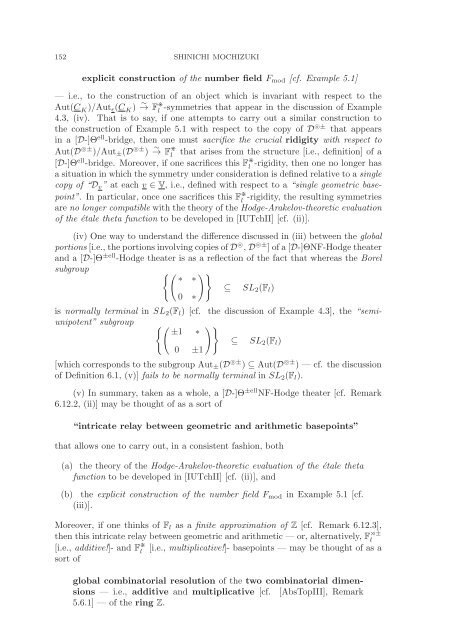Inter-universal Teichmuller Theory I: Construction of Hodge Theaters
Inter-universal Teichmuller Theory I: Construction of Hodge Theaters
Inter-universal Teichmuller Theory I: Construction of Hodge Theaters
Create successful ePaper yourself
Turn your PDF publications into a flip-book with our unique Google optimized e-Paper software.
152 SHINICHI MOCHIZUKI<br />
explicit construction <strong>of</strong> the number field F mod [cf. Example 5.1]<br />
— i.e., to the construction <strong>of</strong> an object which is invariant with respect to the<br />
Aut(C K )/Aut ɛ (C K ) → ∼ F l<br />
-symmetries that appear in the discussion <strong>of</strong> Example<br />
4.3, (iv). That is to say, if one attempts to carry out a similar construction to<br />
the construction <strong>of</strong> Example 5.1 with respect to the copy <strong>of</strong> D ⊚± that appears<br />
in a [D-]Θ ell -bridge, then one must sacrifice the crucial ridigity with respect to<br />
Aut(D ⊚± )/Aut ± (D ⊚± ) → ∼ F l<br />
that arises from the structure [i.e., definition] <strong>of</strong> a<br />
[D-]Θ ell -bridge. Moreover, if one sacrifices this F l<br />
-rigidity, then one no longer has<br />
a situation in which the symmetry under consideration is defined relative to a single<br />
copy <strong>of</strong> “D v ” at each v ∈ V, i.e., defined with respect to a “single geometric basepoint”.<br />
In particular, once one sacrifices this F l<br />
-rigidity, the resulting symmetries<br />
are no longer compatible with the theory <strong>of</strong> the <strong>Hodge</strong>-Arakelov-theoretic evaluation<br />
<strong>of</strong> the étale theta function to be developed in [IUTchII] [cf. (ii)].<br />
(iv) One way to understand the difference discussed in (iii) between the global<br />
portions [i.e., the portions involving copies <strong>of</strong> D ⊚ , D ⊚± ]<strong>of</strong>a[D-]ΘNF-<strong>Hodge</strong> theater<br />
and a [D-]Θ ±ell -<strong>Hodge</strong> theater is as a reflection <strong>of</strong> the fact that whereas the Borel<br />
subgroup {( )} ∗ ∗<br />
⊆ SL 2 (F l )<br />
0 ∗<br />
is normally terminal in SL 2 (F l ) [cf. the discussion <strong>of</strong> Example 4.3], the “semiunipotent”<br />
subgroup {( )}<br />
±1 ∗<br />
⊆ SL 2 (F l )<br />
0 ±1<br />
[which corresponds to the subgroup Aut ± (D ⊚± ) ⊆ Aut(D ⊚± ) — cf. the discussion<br />
<strong>of</strong> Definition 6.1, (v)] fails to be normally terminal in SL 2 (F l ).<br />
(v) In summary, taken as a whole, a [D-]Θ ±ell NF-<strong>Hodge</strong> theater [cf. Remark<br />
6.12.2, (ii)] may be thought <strong>of</strong> as a sort <strong>of</strong><br />
“intricate relay between geometric and arithmetic basepoints”<br />
that allows one to carry out, in a consistent fashion, both<br />
(a) the theory <strong>of</strong> the <strong>Hodge</strong>-Arakelov-theoretic evaluation <strong>of</strong> the étale theta<br />
function to be developed in [IUTchII] [cf. (ii)], and<br />
(b) the explicit construction <strong>of</strong> the number field F mod in Example 5.1 [cf.<br />
(iii)].<br />
Moreover, if one thinks <strong>of</strong> F l as a finite approximation <strong>of</strong> Z [cf. Remark 6.12.3],<br />
then this intricate relay between geometric and arithmetic — or, alternatively, F ⋊±<br />
l<br />
[i.e., additive!]- and F l<br />
[i.e., multiplicative!]- basepoints — may be thought <strong>of</strong> as a<br />
sort <strong>of</strong><br />
global combinatorial resolution <strong>of</strong> the two combinatorial dimensions<br />
— i.e., additive and multiplicative [cf. [AbsTopIII], Remark<br />
5.6.1] — <strong>of</strong> the ring Z.
















